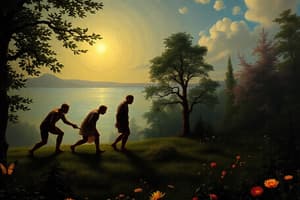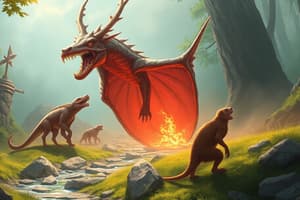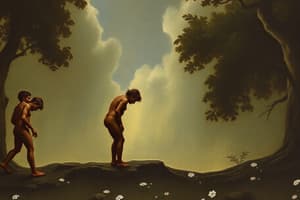Podcast
Questions and Answers
What is biological evolution primarily concerned with?
What is biological evolution primarily concerned with?
- The physical features of organisms that develop during a lifetime
- The immediate changes in organisms during their lifetime
- The diverging of living things from shared ancestors (correct)
- The memorization of behaviors in newborns
Which of the following processes is NOT a form of adaptation for survival and reproduction?
Which of the following processes is NOT a form of adaptation for survival and reproduction?
- Structural adaptations
- Physiological adaptations
- Emotional adaptations (correct)
- Behavioral adaptations
What is the primary way developmental changes differ from evolutionary changes?
What is the primary way developmental changes differ from evolutionary changes?
- Developmental changes occur within an individual's lifetime. (correct)
- Developmental changes are influenced by environmental factors.
- Developmental changes result from genetic mutations.
- Developmental changes are inheritable.
How do penguins exhibit structural adaptations?
How do penguins exhibit structural adaptations?
Which statement best describes a behavioral adaptation?
Which statement best describes a behavioral adaptation?
What role does memory play in the adaptation process of organisms?
What role does memory play in the adaptation process of organisms?
Which of the following is an example of a physiological adaptation?
Which of the following is an example of a physiological adaptation?
What aspect of evolution do scientists generally agree upon?
What aspect of evolution do scientists generally agree upon?
What type of mutation results in no benefit or harm to an organism's survival or reproduction?
What type of mutation results in no benefit or harm to an organism's survival or reproduction?
What is lactase persistence an example of?
What is lactase persistence an example of?
Which mutation is associated with Huntington’s Disease?
Which mutation is associated with Huntington’s Disease?
What does evolutionary adaptation refer to?
What does evolutionary adaptation refer to?
What is an example of a beneficial mutation?
What is an example of a beneficial mutation?
Which scenario describes a neutral trait in a population?
Which scenario describes a neutral trait in a population?
How can mutations lead to changes in a species population over generations?
How can mutations lead to changes in a species population over generations?
What effect can a mutation that is disadvantageous have on a species?
What effect can a mutation that is disadvantageous have on a species?
What is the primary reason why penguins breed in winter?
What is the primary reason why penguins breed in winter?
What is a physiological adaptation that helps male penguins survive during winter?
What is a physiological adaptation that helps male penguins survive during winter?
How do mutations contribute to genetic variation in a population?
How do mutations contribute to genetic variation in a population?
What defines evolutionary change within a species population?
What defines evolutionary change within a species population?
Which behavioral adaptation involves caring for offspring?
Which behavioral adaptation involves caring for offspring?
Why is the slowing of a penguin's resting heart rate during dives an important adaptation?
Why is the slowing of a penguin's resting heart rate during dives an important adaptation?
What is a result of favorable mutations being passed down through generations?
What is a result of favorable mutations being passed down through generations?
Which of the following processes directly affects individuals and can influence future generations?
Which of the following processes directly affects individuals and can influence future generations?
What are the possible impacts of a mutation depending on the environment?
What are the possible impacts of a mutation depending on the environment?
Why are beneficial mutations significant to species evolution?
Why are beneficial mutations significant to species evolution?
What cells are most adversely affected by radiation exposure, particularly in acute radiation sickness?
What cells are most adversely affected by radiation exposure, particularly in acute radiation sickness?
What was a significant outcome of the Chernobyl disaster in terms of health?
What was a significant outcome of the Chernobyl disaster in terms of health?
How does the environment influence the expression of mutations?
How does the environment influence the expression of mutations?
Which of the following was a direct result of the Chernobyl reactor explosion?
Which of the following was a direct result of the Chernobyl reactor explosion?
What characterizes a trait that is beneficial in a specific environment?
What characterizes a trait that is beneficial in a specific environment?
What is the relationship between mutations and evolutionary processes?
What is the relationship between mutations and evolutionary processes?
Flashcards
Biological Evolution
Biological Evolution
The scientific theory that explains how living organisms evolve from common ancestors over long periods of time.
Structural Adaptations
Structural Adaptations
Changes in an organism's body that help it survive and reproduce in its environment.
Behavioral Adaptations
Behavioral Adaptations
Actions or behaviors of an organism that help it survive and reproduce.
Physiological Adaptations
Physiological Adaptations
Signup and view all the flashcards
Development
Development
Signup and view all the flashcards
Evolution - Universal Aspect
Evolution - Universal Aspect
Signup and view all the flashcards
Scientific Debate on Evolution
Scientific Debate on Evolution
Signup and view all the flashcards
Heritable Changes
Heritable Changes
Signup and view all the flashcards
Fitness
Fitness
Signup and view all the flashcards
Mutation
Mutation
Signup and view all the flashcards
Inheritance
Inheritance
Signup and view all the flashcards
Evolution
Evolution
Signup and view all the flashcards
Natural Selection
Natural Selection
Signup and view all the flashcards
Neutral Mutation
Neutral Mutation
Signup and view all the flashcards
Harmful Mutation
Harmful Mutation
Signup and view all the flashcards
Beneficial Mutation
Beneficial Mutation
Signup and view all the flashcards
Evolutionary Adaptation
Evolutionary Adaptation
Signup and view all the flashcards
Derived Trait
Derived Trait
Signup and view all the flashcards
Gene Pool
Gene Pool
Signup and view all the flashcards
Frequency
Frequency
Signup and view all the flashcards
Favorable Trait
Favorable Trait
Signup and view all the flashcards
Mutation and Environment
Mutation and Environment
Signup and view all the flashcards
Mutation Impact
Mutation Impact
Signup and view all the flashcards
Adaptive Evolution
Adaptive Evolution
Signup and view all the flashcards
Study Notes
Earth's Timeline
- Earth formed 4.54 billion years ago (bya)
- Meteorite bombardment occurred from 4.54 to 3.8 bya
- Polymerization occurred 4 bya
- Volcanoes and molten rock appeared 5 bya
- UV light appeared 5 bya
- CO₂ and NO₂ were present 4 bya
- First protocells appeared 3.5 bya
- Bacteria appeared 3.2 bya
- Bacterial colonies appeared 2 bya
- Cyanobacteria appeared 2.5 bya
- First eukaryotes appeared 1.2 bya
- First vertebrates (sea invertebrates) appeared 700 mya
- Plants, amphibians, reptiles appeared 300 mya
- Fish, algae, fungi appeared 700 mya
- Dinosaurs, birds, insects appeared 240 mya
- Primates appeared 65 mya
- Humans appeared 1.5 mya
Earth's History
- The timeline is represented by a clock, with significant events marked.
- Earth formation is at 0:00
- Formation of life is at 4 am
- Oldest fossils discovered at 5:36 am
- Early life with abundant banded iron-formations from 6 am to 1:52 pm.
- Single-celled algae appeared at 2:08 pm
- Sexual reproduction started at 6:08 pm
- Land plants appeared at 9:52 pm
- Coal swamps occurred at 10:24 pm
- Dinosaurs appeared at 10:56 pm
- Mammals appeared at 11:39 pm
- Humans appeared at 11:58:43 pm
Inquiry Questions
- How has the Earth changed over time?
- Do organisms change? How? In what ways?
- Are changes in organisms passed on from generation to generation?
What is Evolution?
- Biological evolution is the scientific theory that states that living things have diverged from shared ancestors.
- Evolution is also the idea that the universe has a history and that change over time has taken place.
- Scientists have questions about evolution and often disagree on patterns and processes of evolution, but they do not question whether evolution has occurred.
Earth and Solar Systems
- There are diagrams showing the Earth-centered solar system and the Sun-centered solar system.
What is Evolution (Videos)
- There are links to YouTube videos about evolution, discussing 4 billion years of evolution in 6 minutes, a science career, and about what evolution is.
Changes During a Lifetime
- Development involves physical changes during an individual's lifetime, resulting from growth or aging.
- Cosmetic alterations and accidental scars are not inherited.
- Stages of development are depicted with newborns, adults, and advanced ages, highlighting visible differences.
Adaptations
- Adaptations, structural, behavioral and physiological processes, assist organisms in survival and reproduction.
- Penguin adaptations (structural, behavioral, physiological) are described, including short, stiff tails for balance, winter huddling for warmth, and dietary behaviours to conserve energy when food is scarce.
Other Behavioral Adaptations
- Other primates, such as monkeys, exhibit behaviors like swinging (commuting), grooming, socializing, exploring, examining unfamiliar food sources, and caring for their young.
Physiological Adaptations
- Male penguins can survive for 100 days without food.
- Penguins' resting heart rates slow down during dives for better oxygen conservation and extended foraging.
How do These Adaptations Arise in a Population?
- Adaptations arise from genetic variation in populations, which originate from mutations.
- Mutations create new gene versions (alleles), introducing new genetic information.
- Beneficial mutations enhance reproductive success and are often favored by the environment.
Evolution and Genetic Variation
- Mutations are the original source of genetic variation, providing a continuous supply of new genetic information.
- Mutations directly affect individuals and influence future generations when they are inherited.
- Mutations' impact depends on the environment.
Changes Between Generations
- Evolutionary change occurs when inheritable traits of a species differ, facilitated by favourable traits.
- Favourable characteristics are passed on to successive generations, leading to changes in the species.
- Neutral traits persist in the population at low frequencies.
- Harmful traits are lost over time in the population
Neutral Mutations
- A neutral mutation is one that does not benefit or harm the individual's chance of survival or reproduction.
- Lactase, an enzyme in milk digestion, experiences a genetic switch in some individuals allowing them to consume milk as adults.
Harmful Mutations
- Harmful mutations decrease the reproductive success of an organism.
- The HHT gene mutation potentially causes Huntington's disease.
Beneficial Mutations
- Beneficial mutations improve reproductive success, granting organisms an advantage.
- The sickle-cell allele provides resistance to malaria, increasing survival in malaria-prone regions.
Mutations and the Environment
- The impact of a mutation depends on the environment in which it is expressed..
- The same mutation can be harmful in one environment, neutral in another, and beneficial in a different environment.
- Examples of mutations’ diverse effects are provided, such as hemoglobin mutations affecting high-altitude survival.
Life After Chernobyl
- On April 26, 1986, a reactor explosion occurred due to flawed design and inexperienced workers at Chernobyl.
- The explosion resulted in acute radiation sickness (ARS), causing deaths.
- Radiation is most damaging to rapidly dividing cells, leading to common symptoms like vomiting and hair loss.
- 237 people suffered acute radiation sickness, with 28 deaths within 4 months of high radiation exposure. 7000 cases of thyroid cancer were recorded.
Studying That Suits You
Use AI to generate personalized quizzes and flashcards to suit your learning preferences.




